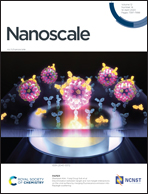A nanopatterned dual reactive surface driven by block copolymer self-assembly†
Abstract
Herein, we report the selective functionalization of nano-domains obtained by the self-assembly of a polystyrene-block-poly(vinyl benzyl azide) PS-b-PVBN3 copolymer synthesized in three steps. First, a polystyrene macro-initiator was synthesized, and then extended with vinyl benzyl chloride by nitroxide mediated polymerization to form polystyrene-block-poly(vinyl benzyl chloride) PS-b-PVBC. Nucleophilic substitution of vinyl benzyl chloride into a vinyl benzyl azide moiety is finally performed to obtain PS-b-PVBN3 which self-assembled into nano-domains of vinyl benzyl azide PVBN3. Click chemistry was then used to bind functional gold nanoparticles and poly(N-isopropylacrylamide) (PNIPAM) on PVBN3 domains due to the specific anchoring at the surface of the nanopatterned film. Atomic force microscopy (AFM) was used to observe the block copolymer self-assembly and the alignment of the gold nanoparticles at the surface of the PVBN3 nanodomains. Thorough X-ray photoelectron spectroscopy (XPS) analysis of the functional film showed evidence of the sequential grafting of nanoparticles and PNIPAM. The hybrid surface expresses thermo-responsive properties and serves as a pattern to perfectly align and control the assembly of inorganic particles at the nanoscale.



 Please wait while we load your content...
Please wait while we load your content...